This Eriogonum is another of those high elevation gems. It's range runs along the Sierra Nevada and Cascade Ranges from central California through to British Columbia.. In Nevada it makes it's way eastward just into the western counties of Utah. It is found in CA, NV, ID, OR, WA, UT, and BC.
This eriogonum is locally found at elevations of 8,000'-11,000' on decomposed granite, screes and fell fields. The flowers have a range of colors from white/cream to rose/red. It is mat forming with the flowers held from 0-3" above the foliage.
http://plants.usda.gov/java/profile?symbol=EROVN
http://www.calflora.org/cgi-bin/species_query.cgi?where-taxon=Eriogonum+...
http://calphotos.berkeley.edu/cgi/img_query?stat=BROWSE&query_src=photos...
http://www.cnps.org/cnps/nativeplants/gallery/ingram/erio07.jpg
These photos were taken on a trip this summer from the Carson Pass to Winnemucca Lake in the central Sierras of California. We stopped along the trail to explore the fell fields on the north shore Frog Lake. We were rewarded for our efforts handsomely.
Comments
Re: Eriogonum ovalifolium var. nivale
John, is that Sedum lanceolatum in the last few pictures? It's a beautiful contrast, whatever it is.
Re: Eriogonum ovalifolium var. nivale
Peter
Yes it is! Good ID!
Re: Eriogonum ovalifolium var. nivale
Mark
I predict that your plant will make a full recovery. By the way I like the pot redressing.
The area was spectacular!! ;D
Antennaria rosea ssp. rosea, Eriogonum umbellatum var. nevadense, Ipomopsis tenuituba, Ivesia gordonii, Leptodactylon californicum, Penstemon newberryi, Penstemon speciosus, Polemonium pulcherrimum, Stenotus acaulis, Sedum lanceolatum, Heuchera rubescens var. rybergiana, Mimulus mephiticus (in both the pink and yellow forms) and of course Eriogonum ovalifolium var. nivale. They were all mingled together in full bloom.
Re: Eriogonum ovalifolium var. nivale
Absolutely spectacular buckwheats, John!
Yours looks very much at home in the new pot, Mark. I was just reflecting on the amount of leaf variation among the Calphoto pix you posted... and still pondering whether what I see in the mountains here is E. ovalifolium var. ovalifolium or E. androsaceum... ? I'll post some photos in a separate thread and see what the experts say! :)
Re: Eriogonum ovalifolium var. nivale
Lori
They are great little mats. I will be on the look out for seed or seedlings. I know for my part any of the color forms would be a boon to my expanding Eriogonum collection.
Re: Eriogonum ovalifolium var. nivale
The area was spectacular!! ;D
Antennaria rosea ssp. rosea, Eriogonum umbellatum var. nevadense, Ipomopsis tenuituba, Ivesia gordonii, Leptodactylon californicum, Penstemon newberryi, Penstemon speciosus, Polemonium pulcherrimum, Stenotus acaulis, Sedum lanceolatum, Heuchera rubescens var. rybergiana, Mimulus mephiticus (in both the pink and yellow forms) and of course Eriogonum ovalifolium var. nivale. They were all mingled together in full bloom.
I remember of my western USA wanderings coming across such natural rock gardens, my most vivid memory is of a spot in Idaho on way heading north towards the Sawtooth Mountains. There was an area of large black basalt outcrops, hundreds of feet high but quite manageable to walk on, the dark black rock an amazing backdrop for several Eriogonums, but the sugar candy pink E. ovalifoliums were the best, a number of penstemons including the exquisite Penstemon montanus ssp. idahoensis, P. ellipticus, a near blue-leaf Draba that I wasn't able to key, Castillejas, Erigerons, the most minute of American Alliums A. simillimum, and many others.
And Lori, I too still wonder about the whole E. ovalifolium var. ovalifolium or E. androsaceum thing, from the photos Cohan posted on SRGC, Alberta Wanderings: http://www.srgc.org.uk/smf/index.php?topic=5641.msg170030#msg170030
I thought of asking James reveal to take a look, maybe I'll follow through with that intention. :)
Re: Eriogonum ovalifolium var. nivale
And Lori, I too still wonder about the whole E. ovalifolium var. ovalifolium or E. androsaceum thing, from the photos Cohan posted on SRGC, Alberta Wanderings: http://www.srgc.org.uk/smf/index.php?topic=5641.msg170030#msg170030
I thought of asking James reveal to take a look, maybe I'll follow through with that intention. :)
Mark, I have a lot of much more detailed photos of the plant(s) in question... at least the ones that are in question from my point of view, which I believe to be the same plant that Cohan showed... that I will post. I have photos that I believe captured the features that are said to distinguish these species, though I am still confused about the ID due to what seems to me to be some conflicting info...
Re: Eriogonum ovalifolium var. nivale
Weiser, How I would love to grow Eriogonums! I first saw pictures many years ago and have tried several times. Some plants survive for years but never flower. They all however, succumb to wet winters (or competition from moss saxifrages etc).
Mark, I don't laugh at your wiggy-stone! I have some myself! I like mosscovered stones.
Re: Eriogonum ovalifolium var. nivale
What I love about these things is the variability of flower color (and buds), and the color the flowers fade to.
Here in Colorado I have had great success with plants in troughs as well as in the rock garden, tucked into a few corners. Mark is absolutely correct in stating the variability and progression of flower color. You may see a small picture of one from my garden on the home page of the Eriogonum Society website. This particular plant was well traveled in it's infancy. After the Penstemon Society meeting in Bishop, CA a few years ago I purchased it from Rebecca Lance at Granite Gardens Nursery in Sonora, CA, took it and my wife to San Francisco, and then drove it zigzagging across Nevada and Utah back to Colorado without killing it!
Sorry, I cannot find the original picture on this computer....
I recommend this one to those of you who have a lean scree.

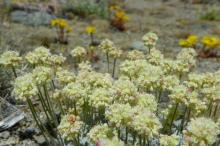
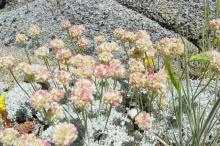
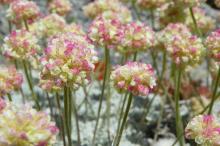
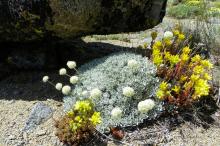
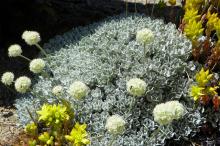
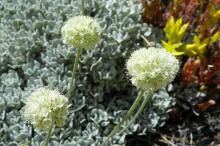
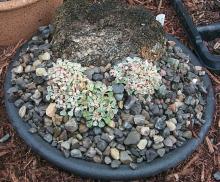
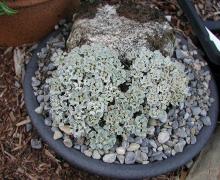
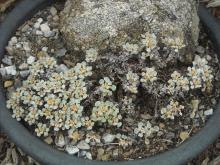
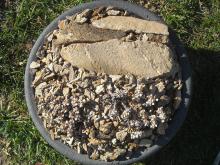
John, these are once again spectacular buckwheats, the pictures in the wild look like they're in a natural rock garden, glorious cushions of silver foliage even if they didn't bloom. What I love about these things is the variability of flower color (and buds), and the color the flowers fade to. Everyone, do check out the Calphotos link John provided :o, although for a few selected color forms from Calphotos, here are some favorite links:
white and pinkish
http://calphotos.berkeley.edu/cgi/img_query?enlarge=0000+0000+0808+1577
bright pink
http://calphotos.berkeley.edu/cgi/img_query?enlarge=0000+0000+1202+0076
pink and cream
http://calphotos.berkeley.edu/cgi/img_query?enlarge=0000+0000+0705+0988
red-orange
http://calphotos.berkeley.edu/cgi/img_query?enlarge=0024+3291+4863+0023
red:
http://calphotos.berkeley.edu/cgi/img_query?enlarge=0000+0000+1209+1230
This is the only Eriogonum I currently have, from Ran Ratko seed in year 2000. I show 4 photos, where I have it planted in one of Phil Pearson's very special high-fire non-winter-breaking pots made for growing alpines and wildflowers. Don't laugh at the rock I placed in the pot, it has dried moss on it and looks like a wig ;D
1 Young plants grew quickly in 2001, photo taken in autumn shows pinkish color the foliage takes on.
2. Plant filled out the following year, photographed with nice foliage in August. This rarely blooms for me, flowers are palest yellow,
almost see-through, and rather disappointing, but I like the foliage.
3. The same plant in October this year, 2010, the plant was in decline and engulfed in moss so dense that it was hard to the touch.
The photo was taken after I carefully extracted all the moss off.
4. The same plant a few days ago in November, the rosettes hunkering down for winter, but I did remove the ugly rock and replaced
it with some natural shale-like rock that's on my property when I dig, topdressed with the same natural rock that I hammer into small
gravel-sized pieces. I hope this rejuvenates this 10-year plant.